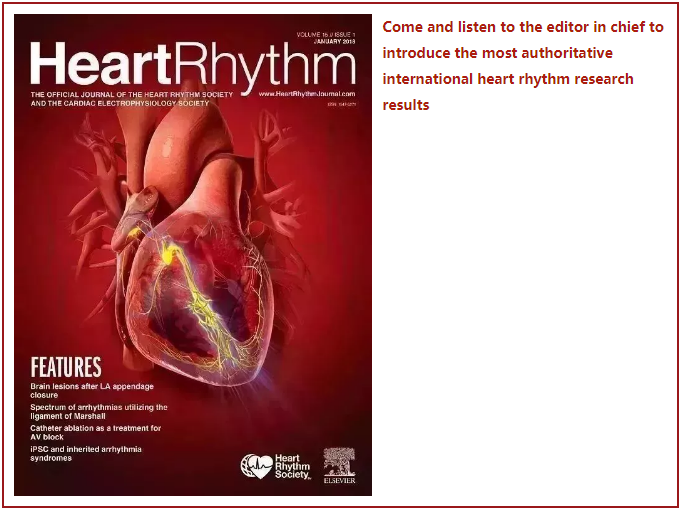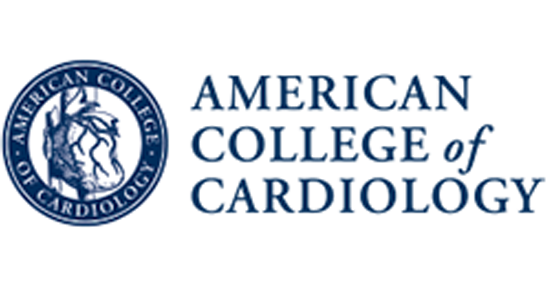HeartRhythm主编—陈鹏生教授语音速递(三月刊 英文版)


Peng-Sheng Chen
Hello, this is Dr. Peng-Sheng Chen, the Editor-in-Chief of Heart Rhythm. I am summarizing the March 2022 issue of the journal.
The first article is “Adding Six Short Lines on Pulmonary Vein Isolation Circumferences Reduces Recurrence of Paroxysmal Atrial Fibrillation: Results from the Multicenter, Single-blind, Randomized Trial”. In this multicenter, singleblind, randomized trial, a total of 390 patients with paroxysmal AF were randomly assigned to the PVI alone group (n = 193) or the PVI+6 line group (n = 197). The authors found that freedom from atrial tachyarrhythmia was achieved in 160 of 197 patients (81.2%) in the PVI+6L group and 142 of 193 patients (73.6%) in the PVI alone group. The authors conclude that in patients with paroxysmal AF undergoing catheter ablation, adding 6 short ablation lines on the PVI circumferences could reduce the AF recurrence rate.
A second paper is titled “Long-term Monitoring of Arrhythmias with Cardiovascular Implantable Electronic Devices in Patients with Cardiac Sarcoidosis”. A retrospective study was performed in 547 predominantly Caucasian patients with extracardiac sarcoidosis screened for cardiac involvement. In total, 105 patients were included and the mean follow-up was 33 months. The authors found that in cardiac sarcoidosis patients without overt cardiac symptoms at initial presentation the annualized overall event rate was 1.7%. It was 10% in high-risk patients, but only 0.4% in low-risk patients. In low-risk patients long-term arrhythmia monitoring with an ILR enabled early detection of clinically important arrhythmias without showing impact on prognosis.
The next one is “Implantable Cardioverter-Defibrillator (ICD) Lead Monitoring Diagnostic Alerts Facilitate the Diagnosis of Structural Lead Failure”. The purpose of this study was to prospectively study the performance of Medtronic ICD lead monitoring alerts. In 4942 patients who were followed for 19 months, there were 124 alerts. Lead monitoring alerts had 100% sensitivity for the 48 adjudicated lead failures. The positive predictive value of alerts for lead failure was 38.7% (48 of 124). However, the sensitivity was only 13.6% for lead dislodgments or perforations. The authors conclude that lead monitoring alerts had 100% sensitivity for identifying lead failures. Although their positive predictive value was modest, no false-positive alerts resulted in an unnecessary lead replacement. For the diagnosis of pace-sense lead failure, an alert for oversensing was more sensitive than a pacing impedance threshold alert.
Next up is “Magnetic Field-Induced Interactions between Phones Containing Magnets and Cardiovascular Implantable Electronic Devices: Flip It to be Safe?” The purpose of this prospective single-center observational study was to quantify the risk of magnetic field interactions of the iPhone 12 with CIEDs. Ex vivo, magnetic interference occurred in 84.6% with the back compared to 46.2% with the front of the iPhone 12 facing the CIED. In vivo, activation of the magnet-sensitive switch occurred in 30 CIED patients (18.3%) when the iPhone 12 was placed in close proximity over the CIED pocket and the back of the phone was facing the skin. The authors conclude that magnetic field interactions occur only in close proximity and with precise alignment of the iPhone 12 and CIEDs. It is important to advise CIED patients to not put the iPhone 12 directly on the skin above the CIED. Further recommendations are not necessary.
The following article is “Bradyarrhythmias Detected by Extended Rhythm Recording in Patients Undergoing Transcatheter Aortic Valve Replacement (BRADY-TAVR Study)”.This was a prospective single-center study in patients undergoing TAVR. Patients received an ECG patch for 2 weeks pre-, immediately post-, and 2-3 months post-TAVR. Pacemaker implantation occurred in 12 patients (12.5%), of whom 9 (9.4%) underwent implantation during their index hospitalization while 3 (3.1%) required implantation postdischarge for indications other than heart block. Significant baseline predictors for the need for pacemaker included the presence of right bundle branch block and increased QRS duration. Bradyarrhythmias detected by the ECG patch did not predict the need for PPM at either the index hospitalization or the follow-up period. The authors conclude that bradyarrhythmias are common and can be detected with extended ECG monitoring before and after TAVR; however, they did not predict the need for pacemaker after TAVR.
Coming up is “Risk Factors for Atrioventricular Block after Occlusion for Perimembranous Ventricular Septal Defect”. The authors reviewed 1884 patients with perimembranous VSD who had undergone successful device occlusion between June 2005 and January 2020. In total, 14 patients (0.7%) developed permanent complete AV block. Of these patients, 10 (0.5%) required pacemaker implantation. The authors conclude that the incidences of permanent complete AV block after occlusion for perimembranous VSD and pacemaker implantation were 0.7% and 0.5%, respectively. The ratio of device to defect size was the only independent risk factor for permanent complete AV block. Device removal is an effective therapeutic modality for recovering normal conduction in acute and subacute complete AV block patients.
Up next is “High Density Epicardial Mapping in Brugada Syndrome: Depolarization and Repolarization Abnormalities”. Fifteen consecutive patients were included in the study. At electroanatomical mapping before ajmaline, 7 patients (46.7%) showed low frequency potentials. All patients showed high frequency potentials before and after ajmaline and low frequency potentials after ajmaline. BrS patients with history of aborted sudden cardiac death had longer abnormal electrograms after ajmaline. The authors conclude that two different types of abnormal electrograms are described from BrS high-density epicardial mapping. This might correlate with depolarization and repolarization abnormalities.
The following article is “Mechanism of the Effects of Sodium Channel Blockade on the Arrhythmogenic Substrate of Brugada Syndrome”. Thirty-two patients with BrS and frequent ventricular fibrillation episodes underwent right ventricular outflow tract substrate electroanatomical and electrocardiographic imaging (ECGI) mapping before and after ajmaline administration and during high-rate atrial pacing. The authors found that sodium current reduction with ajmaline severely compromises impulse conduction at the BrS fibrotic substrates by producing fractionated electrograms, conduction block, or excitation failure, leading to the Brugada ECG pattern and favoring ventricular fibrillation genesis.
Up next is “Multisite Conduction Block in the Epicardial Substrate of Brugada Syndrome”. The authors investigated 6 male patients with BrS and recurrent ventricular fibrillation. They found that all patients had a region in the anterior epicardial right ventricle with prolonged multicomponent electrograms. Single extrastimulation prolonged late epicardial components by 59 ms and in 4 patients abolished epicardial components at some sites, without reactivation by surrounding activated sites. These localized blocks occurred at an initial coupling interval of 335 ms and then expanded to other sites, being observed in up to 40% of epicardial sites. Ajmaline infusion prolonged electrogram duration in all and produced localized blocks in 62% of sites in the same patients as during extrastimulation. The authors conclude that in BrS, localized functional conduction blocks occur at multiple epicardial sites and with variable patterns, without being reactivated from the surrounding sites.
The next paper is “Sex-Specific Aspects of Phospholamban Cardiomyopathy: the Importance and Prognostic Value of Low-Voltage ECGs”. A pathogenic variant in the gene encoding phospholamban (PLN), a protein that regulates calcium homeostasis of cardiomyocytes, causes PLN cardiomyopathy. It is characterized by a high arrhythmic burden and can progress to severe cardiomyopathy. The authors analyzed a multicenter cohort of 933 patients with the PLN p.(Arg14del) pathogenic variant following up on a recently developed PLN risk model. Of the 933 cohort members, 287 (31%) had ≥1 low-voltage ECG during follow-up. Female sex, age, age at clinical presentation, and proband status predicted low-voltage ECG during follow-up. Sustained ventricular arrhythmia-free survival was lowest in males with lowvoltage ECG. The authors conclude that low-voltage ECGs predict sustained ventricular arrhythmias and are a component of the PLN risk model. Low-voltage ECGs are more common in females, yet prognostic value is greater in males.
Up next is “A Phenotype-Enhanced Variant Classification Framework to Decrease the Burden of Missense Variants of Uncertain Significance in Type 1 Long QT Syndrome”. The purpose of this study was to determine whether a phenotype-enhanced variant classification approach could reduce the Variants of Uncertain Significance (VUS) burden in LQTS genetic testing. Retrospective analysis was performed on 79 KCNQ1 missense variants in 356 patients from Mayo Clinic and an independent cohort of 42 variants in 225 patients from Amsterdam University Medical Center. Each variant was classified initially using the ACMG guidelines and then readjudicated using a phenotype enhanced-ACMG framework that incorporated the LQTS clinical diagnostic Schwartz score plus 4 "LQT1-defining features": broad-based/slow upstroke T waves, syncope/seizure during exertion, swimming-associated events, and a maladaptive LQT1 treadmill stress test. The authors found that phenotype-guided variant adjudication decreased significantly the VUS burden of LQT1 case-derived KCNQ1 missense variants in 2 independent cohorts. This study demonstrates the value of incorporating LQT1-specific phenotype/clinical data to aid in the interpretation of KCNQ1 missense variants identified during genetic testing for LQTS.
The following article is “Safety and Outcome of Nurse-Led Syncope Clinics and ILRimplants”. A retrospective study of all consecutive patients undergoing nurse-led ILR implantations was performed between April 2016 and April 2018. A total of 432 patients with an ILR were identified: 164 (38%) from nurse-led and 268 (62%) from physician-led clinics. Overall, 156 patients (36%) had a change in management as a direct result of ILR findings, with no overall differences between nurse-led and physician-led clinics. The authors conclude that nurse-led ILR implantation was safe and effective. Nurse-led syncope clinics achieved good symptom-rhythm correlation with resultant significant changes to management in comparison to physician-led clinics.
Up next is “Sotalol versus Amiodarone for Postoperative Junctional Tachycardia following Congenital Heart Surgery”. This is a retrospective single-center study of all patients who received IV sotalol or IV amiodarone for postoperative junctional ectopic tachycardia (JET). A total of 32 patients (median age 71 days) received either IV amiodarone or IV sotalol. Amiodarone was successful in treating JET in 75% of cases; sotalol was successful in 83%. The JET rate decreased faster over the first 90 minutes after a sotalol bolus than after an amiodarone bolus; no heart rate difference was seen after 24 hours. The authors conclude that for children with postoperative JET, both IV sotalol and amiodarone are safe and efficacious. IV sotalol may lead to a faster improvement in heart rate.
The next paper is “Pediatric T-wave Memory after Accessory Pthway Ablation in WolffParkinson-White Syndrome”. Pre- and postablation electrocardiograms (ECGs) in patients ≤ 25 years were analyzed over a 5-year period. T-wave memory was present in 42% of pediatric patients, with resolution occurring within 3 months of ablation. Preablation QRS axis <0° was a strong predictor of T-wave memory, followed by posteroseptal pathway location. The authors conclude that T-wave memory is less common in children compared to adults, and normalization occurred within 3 months postablation.
Next up is “Familial Atrial Myopathy in a Large Multi-Generational Heart-Hand Syndrome Pedigree Carrying LMNA Missense Variant in Rod 2B Domain (p.R335W)”. The purpose of this study was to characterize the atrial phenotypes and possible mechanisms in a large Chinese family with heart-hand syndrome carrying a LMNA missense variant in rod 2B domain. In the pedigree investigation, 6 of 13 of the mutation carriers showed heterogeneous cardiac phenotypes and 8 carriers also had brachydactyly. In silico molecular dynamics simulations predicted increased binding energy of the R335W mutant lamin A. Atrial cardiomyocytes expressing R335W showed abnormal nuclear morphology, compromised DNA repair, and dysfunctional contraction. Adult zebrafish expressing mutant lamin A showed increased P wave duration in the electrocardiogram, decreased peak A wave velocity in echocardiography, and atrial lesions under the transmission electron microscope. The authors conclude that LMNA p.R335W mutation leads to familial heart-hand syndrome characterized by an overlapping phenotype of prominent atrial lesions and brachydactyly. The unstable lamin dimerization and impaired DNA repair are possible mechanisms underlying cardiac phenotypes. These findings consolidated the genetic role in the course of atrial arrhythmias and cardiac aging.
The following article is “Mechanistic Insights into the Interaction of Cardiac Sodium Channel Nav1.5 with MOG1 and a New Molecular Mechanism for Brugada Syndrome”. MOG1 is a chaperone that binds to Nav1.5, facilitates Nav1.5 trafficking to the cell surface, and enhances the amplitude of sodium current INa. Large deletion analysis defined the MOG1-Nav1.5 interaction domain to amino acids S476-H585 of Nav1.5 Loop I connecting transmembrane domains I and II. Microdeletion and point mutation analyses further defined the domain. The primary finding is that the MOG1-Nav1.5 interaction domain is at a 5-amino-acid motif of F530T531F532R533R534 in Loop I. Mutation p.F532C associated with BrS abolishes Nav1.5 interaction with MOG1 and reduces MOG1-enhanced INa density, thereby uncovering a novel molecular mechanism for the pathogenesis of BrS.
Up next is a case report titled “Bachmann Bundle Potential during Atrial Lead Placement: A Case Series”. The authors report a novel approach that combines fluoroscopic and electrical mapping to achieve successful Bachmann bundle pacing. The authors demonstrate a localized endocardial electrogram signature that approximates Bachmann bundle and is readily apparent on a standard electrogram recording system. Pacing from an actively fixed lead guided by local Bachmann bundle area endocardial potentials generates a normalized P-wave axis, morphology and corrects baseline interatrial conduction delay. This case series is the first to combine right atrial endocardial potential mapping and pacing response to guide permanent Bachmann bundle pacing site-selection.
These research articles are followed by a contemporary review titled “An Overview of Heart Rhythm Disorders and Management in Myotonic Dystrophy Type 1”.
I hope you enjoyed this podcast. For Heart Rhythm, I’m the Editor-In-Chief, Dr. Peng-Sheng Chen.











